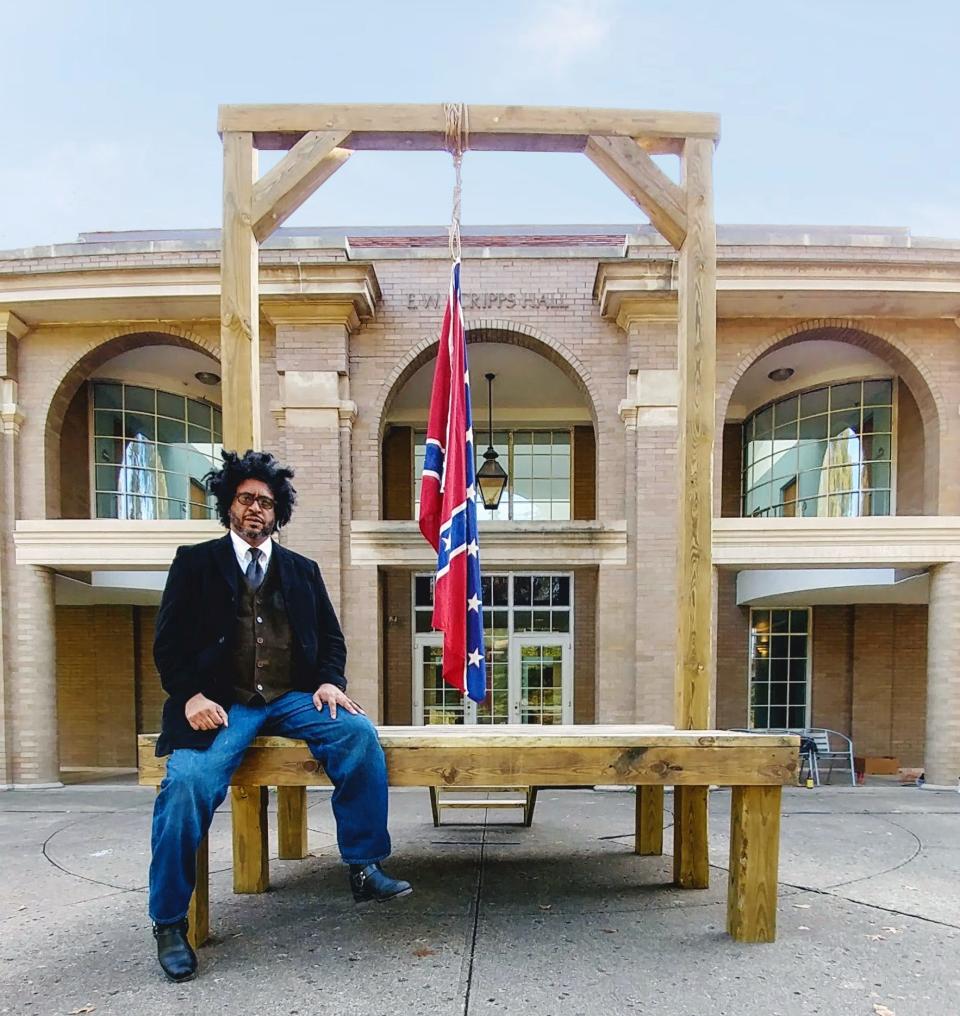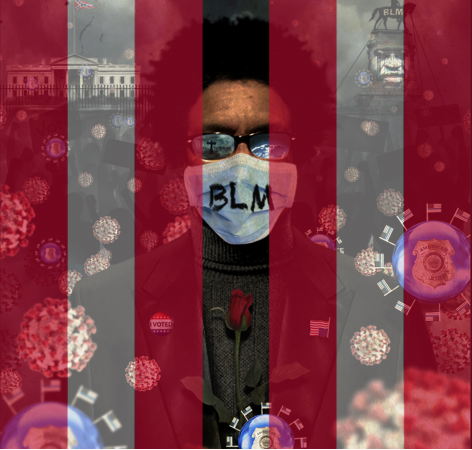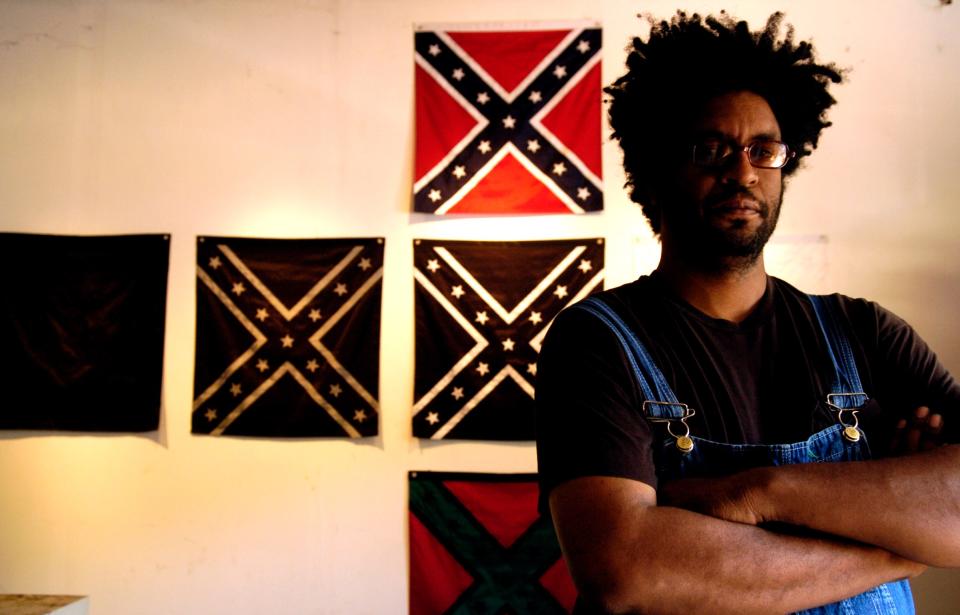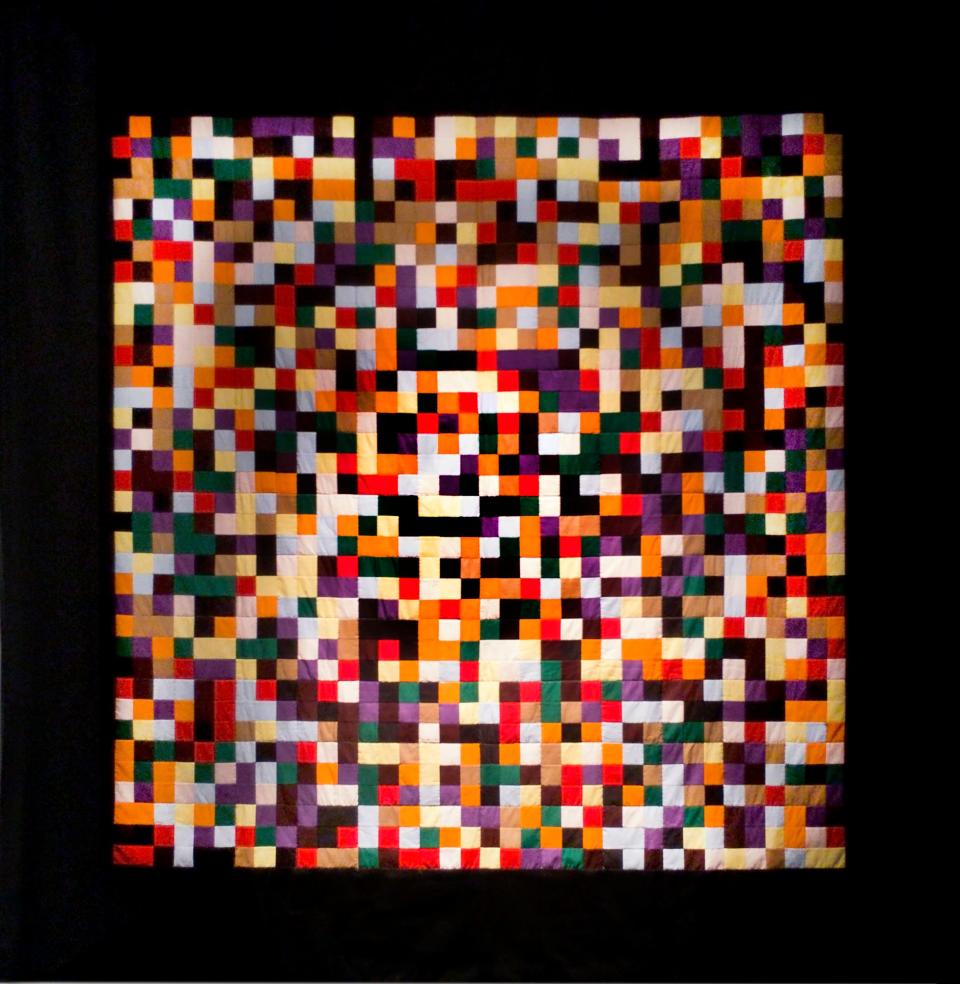John Sims, Sarasota-based conceptual artist and former Ringling professor, dies at 54
Legend. Genius. Esteemed artist. Activist. Humanitarian.
Those are just a few of the words used by those mourning the sudden death of John Sims, a former Ringling professor whose conceptual art challenged a divisive America. He was 54.
“It is with a heavy heart, but calm spirit that we announce that John Sims, our beloved brother and MathArtist, transitioned on Sunday, Dec. 11, 2022 at his home in Sarasota, Florida,” A.T. Sims, his brother, wrote on Facebook.
“As in life, his star now shines brightly,” A.T. wrote. “As family, friends, and supporters, let's lift our eyes to the sky and celebrate John.”
Details for Sims’ celebration of life are to come. No cause of death has been announced.
Sims's art confronted the legacy of the American Civil War and white supremacy, such as his 2001 “Recoloration Proclamation,” a multimedia project featuring a series of Confederate flag installations, including The Proper Way to Hang a Confederate Flag and the annual Memorial Day Confederate flag performance "Burn and Bury."
Besides his visual output, the Detroit native was a mathematician, writer and film director. He was the former coordinator of mathematics at Ringling College of Art and Design, where he created a visual mathematics curriculum for artists and visual thinkers. He left the position in 2005 to pursue art in New York, but not without a proper farewell: three exhibits displaying his work in Sarasota.
In one, former Herald-Tribune art critic Kevin Costello said he reinvented mathematical structures “to serve math’s relationship to natural forms such as trees.” In another, he displayed re-mixed and re-colored national and state flags, in a show with a centerpiece of “The Proper Way to Hang the Confederate Flag,” which was a life-sized gallows from which that flag hung.

In 2020, Sims returned to Ringling as its in-residence artist to work on various projects related to the COVID-19 pandemic, policing, and Confederate symbolism. One of his quarantine projects? "Korona Killa," a video game designed to "help the stress of the lockdown and address the anxiety of a global common enemy."
"The forced isolation gave me the opportunity to both reflect on and respond to the current events," Sims said in a Herald-Tribune column in May 2020. "This pandemic exposes both the pathologies and virtues of modern society and shows how globally connected we are. Also, it shines broad light on the deep disparities and division in our country, especially in the areas of health care. I hope this situation creates an opportunity to rethink our valuable relationship to each other, and the kind of politics and culture that will create more unity and less division.”
Sims also recently penned a tribute to John Chamberlain’s former studio site in Sarasota, published by Sculpture Magazine in September.
He wrote that he passed by the 18,000-square-foot metal structure often, imagining what it would have been like to run into Chamberlain and chat with him over beer.
“I would have asked him to show me his trick with crushing cigarette packs, the very thing that inspired the crinkled car sculptures for which he is so famous,” Sims wrote. “Or what it was like to live on a boat in Sarasota Bay when he first came down to Sarasota, something I’ve always wanted to do.”

Sims finishes the piece by painting the image of him standing before the empty lot that once held space for the iconic artist.
“I pour some coffee libation to the ground in memory, in honor and respect for the spaces that bring forth the best evidence of our humanity and capacity to create. Now, I am ready to get to the studio and work on my newest piece.”
"John was a genius and his intellect was finely tuned and definitely not for the faint of heart. He always challenged you to raise your thinking and perspectives to another level," Thomas Carabasi, the department head of photography and imaging at Ringling, said in an email. "John was relentless in his productivity and made good use of his short time on this planet."
"His influence on the cultural arts in Sarasota was immense and his significant work gained him an international reputation. He will be deeply missed by all those who were lucky enough to know him."
Creative resistance
Sims gained national attention in 2015 after issuing a call for artists to burn or bury the Confederate Flag on July 4, in an effort to “set fire to or shovel dirt on a vestige of the old South,” days after nine Black churchgoers were murdered by a white gunman in South Carolina — who was later found to be waving the flag in previous photographs.
In a NBC News article, Sims described the destruction of the Confederate flag as a form of creative resistance.
“[The July 4 events] are intended to create a space of ceremonial reflection on the complex desire for the death and burial — and perhaps the burning — of the Confederate flag as a symbol of terror, treason, and white supremacy,” Sims said.
Sims was openly critical of present-day visibility of the Confederate flag.

"The flags, statues and monuments normalize language and behavior that celebrate the Confederacy, while defending positions of power both visual and psychological," Sims said in a 2017 Q&A with the Herald-Tribune. "The main agenda and consequence have been the creation of a very harassing environment that promotes segregated histories, fake Civil War narratives and the suppression of historical accountability. To move forward, we must as a nation, have honest and naked conversation about the roots of American racism — slavery and white supremacy."
Suesan Stovall, a friend of Sims, called him a math genius, musical savant and a "true rebel."
"He dared to use the confederate flag as the symbol of the hatred and separation, and burned it to the ground in his work. I am so proud to have worked with him, known him as a brother and as an artist," Stovall wrote in a Facebook post. "He will be missed. Rest in Pi, my friend."

"Good art has a purpose. Some artist create pretty things, and you have other artists who create art that does things," Tim Jaeger, the director and chief curator of galleries and exhibitions at Ringling College, said in an interview with the Herald-Tribune. "(Sims') art confronted issues that our society is grappling with and visually relating them in a way that was confrontational and hopefully changed perspectives. It takes a big person to do that, especially when dealing with the backlash from putting it out there."
Outpouring of grief
Karen Finley, a New York-based performance artist, shared the news of Sims’ passing in a Facebook post, detailing her grief.
“John was a very good friend, who I loved and adored, a collaborator, and we supported each other. He was an amazing artist, educator, activist and humanitarian. He dedicated his life to the arts and social justice,” Finley wrote.
Larry R. Thompson, the president of Ringling College, shared a statement with the Herald-Tribune.
"I was extremely saddened to learn of the untimely passing of John Sims. As a former faculty member at Ringling College of Art and Design from 1997-2005, John built out a unique mathematics curriculum specifically designed for artists and visual thinkers. It was a truly innovative course that is still offered at the College today," Thompson said. "Because John was an internationally recognized artist, writer, lecturer, and activist, many have benefited from his bold voice and unapologetic efforts to create awareness and reform."
Another friend, Keith Crowley, said he was in a state of bewilderment over Sims’ passing.
“John is the embodiment of what it means to be a multidisciplinary artist and thinker. He was constantly challenging me to be a more comprehensive artist and to place a higher value and sense of urgency on my own commitment to the creative process,” Crowley said.
“Rest in Power, John. You left a big wake.”
Those interested in experiencing Sims' work can visit his online portfolio johnsimsproject.com.
This article originally appeared on Sarasota Herald-Tribune: Sarasota artist John Sims dies at 54
